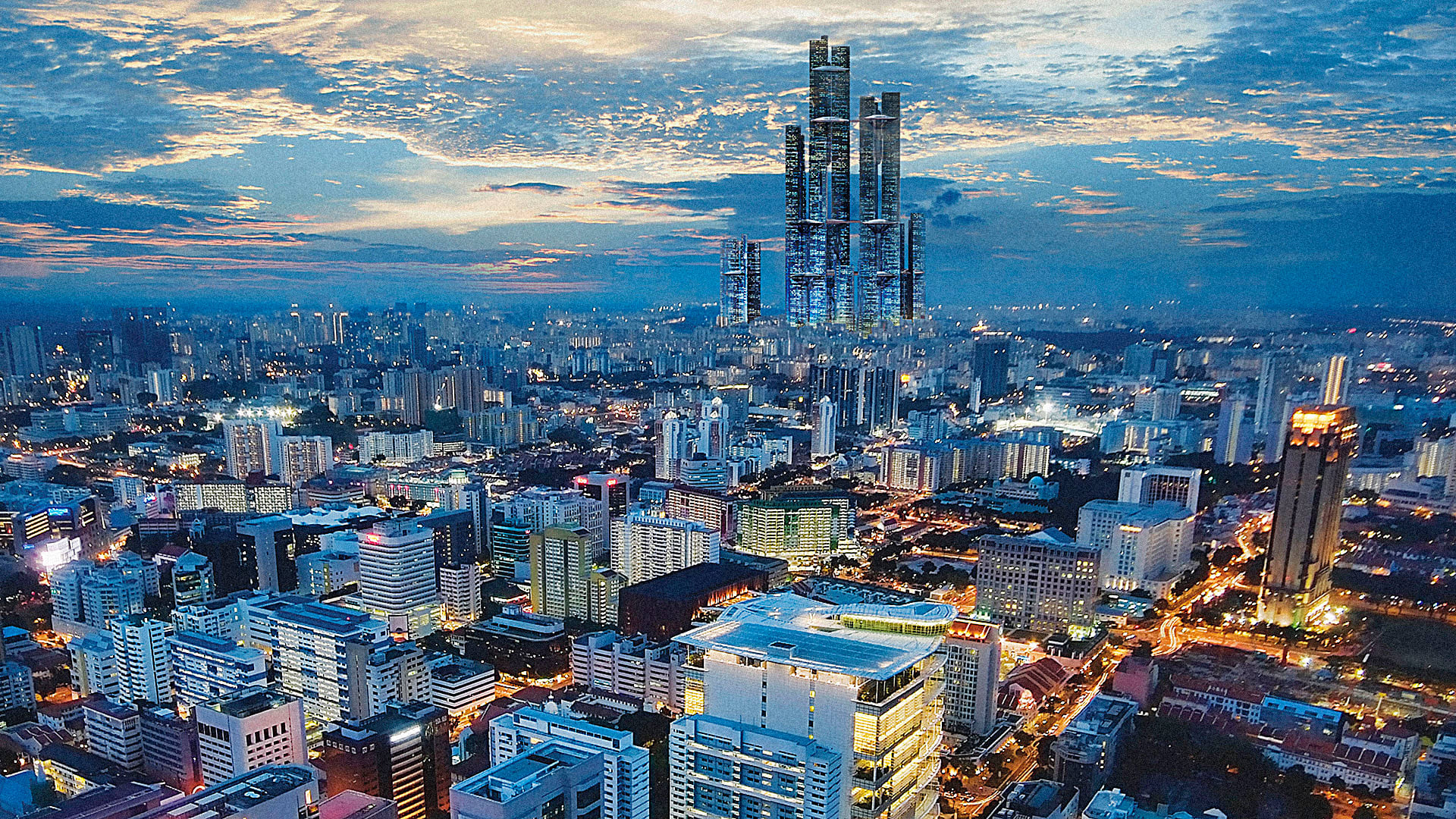TASK 2 (DISCUSS BOTH VIEWS): VERTICAL CITY
Some people think “vertical” city is the best, where people live and work in tall buildings. Others think “horizontal” city is better, where there are few tall buildings. Discuss both these views and give your own opinion.
Sample Answer
It is often argued that upward urban development is the optimal planning strategy, where skyscrapers redefine the skyline and house the vast majority of the population, while detractors of this viewpoint claim otherwise, rooting for lateral city planning absent of high-rises. This essay will shed light on both stances and discuss my personal opinion.
Supporters of vertical urban planning cite legitimate arguments supporting this policy’s primacy. These proponents maintain that urban centres consisting primarily of skyscrapers can solve, to a certain extent, perpetuating housing shortages. Due to the relentless population growth and the skyrocketing rate of urbanisation over the past decades, many people have emigrated from the outskirts, hinterlands, and rural communities to settle in metropolitan areas, thereby raising demand for urban housing. Vertical construction, as a direct solution to this crisis, provides city inhabitants with increased working and living spaces, catering to the ever-growing needs of urban centres. Tall buildings, in addition, can also offer their visitors and dwellers a wide range of commercial, entertainment, and health-related amenities in the form of state-of-the-art shopping malls, recreational hubs, and fitness centres, as is evident in numerous iconic high-rises, such as the symbolic Landmark 81 in Vietnam. These socio-economic and health-related perks therefore make vertical development a favourable provincial planning strategy.
Those arguing in favour of a horizontal metropolis ground their argument on valid environmental benefits. From their perspective, a vertical city, despite its concrete upsides, is far from an eco-friendly proposal. Their criticism is deeply rooted in the fact that skyscrapers are inherently energy-intensive architectural structures, especially those that incorporate commercial facilities such as shopping malls. Within a typical modern high-rise building, both residential units (apartments) and commercial ones (offices, shops, and food courts) consume enormous amounts of electricity on a daily basis in the form of consistent air-conditioning, neon advertisement billboards, and escalators, among other sources. Such consumption is linked to sizeable amounts of greenhouse gas emissions, thereby exacerbating existing climate issues. From the point of view of ‘lateral development’ supporters, this concern is where the horizontal city wins the debate. However, such a proposal may engender urban sprawl, a phenomenon characterised by urban citizens being pushed to the cities’ periphery due to the limited supply of land. This can, in turn, lead to a multitude of social issues, including rising poverty, increasing crime rates, and thus growing social instability. An illustrative example is the notoriously famous ‘favelas’ in Brazil, where there are slum houses for the impoverished who live subsistence lives as a result of unchecked city sprawl.
In conclusion, while I acknowledge the benefits of vertical development in terms of its social, economic, and health benefits, this planning proposal may not be as ecologically efficient as horizontal planning. However, the latter, while being environmentally beneficial, may lead to urban sprawl, exacerbating existing social problems. On balance, a planning strategy incorporating both vertical housing and lateral development in specific regions within cities can strike a balance and provide the optimal solution for both developers and inhabitants.
Marking by Chat GPT
TỪ VỰNG HAY
Some people think “vertical” city is the best, where people live and work in tall buildings. Others think “horizontal” city is better, where there are few tall buildings. Discuss both these views and give your own opinion.
It is often argued that upward urban development is the optimal planning strategy, where skyscrapers redefine the skyline and house the vast majority of the population, while detractors of this viewpoint claim otherwise, rooting for lateral city planning absent of high-rises. This essay will shed light on both stances and discuss my personal opinion.
Supporters of vertical urban planning cite legitimate arguments supporting this policy’s primacy. These proponents maintain that urban centres consisting primarily of skyscrapers can solve, to a certain extent, perpetuating housing shortages. Due to the relentless population growth and the skyrocketing rate of urbanisation over the past decades, many people have emigrated from the outskirts, hinterlands, and rural communities to settle in metropolitan areas, thereby raising demand for urban housing. Vertical construction, as a direct solution to this crisis, provides city inhabitants with increased working and living spaces, catering to the ever-growing needs of urban centres. Tall buildings, in addition, can also offer their visitors and dwellers a wide range of commercial, entertainment, and health-related amenities in the form of state-of-the-art shopping malls, recreational hubs, and fitness centres, as is evident in numerous iconic high-rises, such as the symbolic Landmark 81 in Vietnam. These socio-economic and health-related perks therefore make vertical development a favourable provincial planning strategy.
Those arguing in favour of a horizontal metropolis ground their argument on valid environmental benefits. From their perspective, a vertical city, despite its concrete upsides, is far from an eco-friendly proposal. Their criticism is deeply rooted in the fact that skyscrapers are inherently energy-intensive architectural structures, especially those that incorporate commercial facilities such as shopping malls. Within a typical modern high-rise building, both residential units (apartments) and commercial ones (offices, shops, and food courts) consume enormous amounts of electricity on a daily basis in the form of consistent air-conditioning, neon advertisement billboards, and escalators, among other sources. Such consumption is linked to sizeable amounts of greenhouse gas emissions, thereby exacerbating existing climate issues. From the point of view of ‘lateral development’ supporters, this concern is where the horizontal city wins the debate. However, such a proposal may engender urban sprawl, a phenomenon characterised by urban citizens being pushed to the cities’ periphery due to the limited supply of land. This can, in turn, lead to a multitude of social issues, including rising poverty, increasing crime rates, and thus growing social instability.
In conclusion, while I acknowledge the benefits of vertical development in terms of its social, economic, and health benefits, this planning proposal may not be as ecologically efficient as horizontal planning. However, the latter, while being environmentally beneficial, may lead to urban sprawl, exacerbating existing social problems. On balance, a planning strategy incorporating both vertical housing and lateral development in specific regions within cities can strike a balance and provide the optimal solution for both developers and inhabitants.
Vocabulary
- upward urban development – phát triển đô thị theo chiều cao
- optimal planning strategy – chiến lược quy hoạch tối ưu
- redefine the skyline – thay đổi đường chân trời thành phố
- vast majority of the population – phần lớn dân số
- rooting for – ủng hộ, nghiêng về
- shed light on both stances – làm sáng tỏ hai quan điểm
- cite legitimate arguments – đưa ra lập luận hợp lý
- primacy – vị trí hàng đầu, tính ưu tiên
- urban centres consisting primarily of skyscrapers – trung tâm đô thị chủ yếu gồm nhà chọc trời
- relentless population growth – tăng dân số không ngừng
- skyrocketing rate of urbanisation – tốc độ đô thị hóa tăng vọt
- metropolitan areas – khu vực đô thị lớn
- direct solution to this crisis – giải pháp trực tiếp cho khủng hoảng
- catering to the ever-growing needs – đáp ứng nhu cầu ngày càng tăng
- wide range of commercial, entertainment, and health-related amenities – nhiều tiện ích thương mại, giải trí, sức khỏe
- state-of-the-art shopping malls – trung tâm mua sắm hiện đại nhất
- iconic high-rises – tòa nhà cao tầng mang tính biểu tượng
- socio-economic and health-related perks – lợi ích về xã hội, kinh tế, sức khỏe
- valid environmental benefits – lợi ích môi trường hợp lý
- energy-intensive architectural structures – công trình kiến trúc tiêu tốn năng lượng
- sizeable amounts of greenhouse gas emissions – lượng lớn khí thải nhà kính
- exacerbating existing climate issues – làm trầm trọng thêm vấn đề khí hậu
- engender urban sprawl – gây ra sự lan rộng đô thị
- multitude of social issues – hàng loạt vấn đề xã hội
- strike a balance – đạt được sự cân bằng
✔ DÀN Ý & PARAPHRASING
Introduction – Mở bài
- Main idea:
→ Upward urban development = xây dựng theo chiều cao, đối lập với lateral/horizontal planning = mở rộng theo chiều ngang.
→ Dùng paraphrase thay vì lặp từ city growth / urbanisation:
👉 upward urban development ⇢ vertical city planning ⇢ skyscraper-based growth. - Function: Giới thiệu hai luồng ý kiến, kết thúc bằng “This essay will shed light on both stances and discuss my opinion.” → Cấu trúc essay mở rõ ràng, học thuật.
Body 1 – Vertical development (ủng hộ xây cao tầng)
- Topic sentence: Supporters of vertical urban planning cite legitimate arguments supporting its primacy.
→ Dùng cấu trúc học thuật “cite arguments supporting…” (đưa ra lập luận ủng hộ). - Keyword 1: housing shortages → paraphrase:
→ lack of accommodation / scarcity of residential space / housing crisis. - Keyword 2: population growth & urbanisation → paraphrase:
→ soaring population / demographic boom / rapid urban expansion. - Keyword 3: benefits → paraphrase bằng nhóm từ cụ thể:
→ commercial, entertainment, and health-related amenities ⇢ modern facilities / state-of-the-art infrastructure. - Linking ideas:
→ Vertical construction… provides increased living space → cause–effect link
→ These socio-economic perks make vertical development favourable → kết luận đoạn.
🟩 Key paraphrase chain:
skyscrapers → high-rises → tall buildings → vertical construction → upward development
Body 2 – Horizontal development (xây thấp tầng, trải rộng)
- Topic sentence: Those arguing in favour of a horizontal metropolis ground their argument on valid environmental benefits.
→ paraphrase cho benefits: advantages / merits / upsides. - Keyword 1: energy consumption → paraphrase:
→ energy-intensive structures / electricity use / power demand. - Keyword 2: pollution / climate → paraphrase:
→ greenhouse gas emissions / ecological footprint / environmental degradation. - Keyword 3: urban sprawl → paraphrase:
→ city expansion / uncontrolled suburban growth / outward spread of cities. - Development pattern:
→ Ưu điểm môi trường → nhưng dẫn đến social issues (crime, poverty).
→ engender / give rise to / result in / lead to → các động từ paraphrase cho “cause”.
Conclusion – Kết bài
- Paraphrase of opinion:
→ While vertical development brings social and economic benefits, it may not be as ecologically efficient.
→ A balanced approach incorporating both vertical and lateral planning → paraphrase cho “combine both ideas.”
🟩 Key paraphrase chain:
balanced planning → integrated urban strategy → mixed development model.
Summary of paraphrasing strategy – Cách paraphrase hiệu quả
- Không đổi nghĩa, chỉ đổi “góc nhìn”:
- vertical city → upward urban development
- horizontal city → lateral planning / outward expansion
- Dùng nhóm từ học thuật thay vì từ đơn:
- good → beneficial / favourable / advantageous
- problem → issue / challenge / crisis
- Mở rộng collocations quanh keywords:
- urban sprawl → unchecked city sprawl / uncontrolled expansion
- benefits → socio-economic and health-related perks
- development → urban planning / city design / infrastructure growth
- Tránh lặp bằng cách đổi từ loại (word form shift):
- urbanisation (n) → urbanise (v) → urban growth (n phrase)


